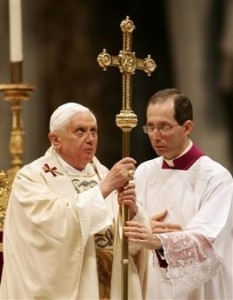ONE OF the stars in the firmament for those who see Benedict XVI as a great restorer of traditional liturgical practices is Msgr. Guido Marini, Pontifical Master of Liturgical Ceremonies. (Pictured below.)
Msgr. Marini, appointed to his post in October 2007, is credited with giving Vatican ceremonies a more traditional look and feel. The spectacularly ugly modern liturgical furnishings used during the days of Paul VI and John Paul II (the dreary, plain chasubles, the bare high altar, the modern “twisted lizard” crucifix) have given way to Baroque miters, elaborate papal thrones, lace cottas, Renaissance altar frontals and embroidered dalmatics. The ceremonial for Masses celebrated in St. Peter’s is now far more elaborate and the tone for everything far more “traditional.”
This shift reflects not merely Msgr. Marini’s ideas on the liturgy, of course, but also those of Benedict XVI, a man of high culture and refined aesthetic sensibilities, who has long lamented many of the developments in the liturgy that occurred after Vatican II.
In January 2010, Msgr. Marini delivered a lengthy address criticizing the effects of the post-Vatican II liturgical reforms. His remarks seemed particularly significant, because one sensed in them an at least implicit awareness that the official reforms themselves — and not merely their application — caused some of the problems he described.
But the solution Msgr. Marini proposes is applying a “hermeneutic of continuity” to the liturgical reform — to maintain that there is no substantial difference between the old liturgy and the new liturgy. “Hermeneutic of continuity” is the buzz phrase, of course, that Benedict XVI uses for his broader theory that Vatican II represented no break at all with previous teaching, but merely continued and developed it.
In a recent interview, Msgr. Marini explained how this notion applies to the liturgy:
The hermeneutic of continuity highlights that in the life of the Church there is an authentic growth in the way in which they do not cut the roots, so that this development includes the richness of its history and tradition.
The phrase “richness of history and tradition” has profound appeal for traditionalists who reject the New Mass and the entire liturgical reform.
But lack of “richness” in the reformed rites is merely a symptom, not a cause. The latter must be sought in doctrinal basis for the Novus Ordo: ecumenism and modernism. The reform did in fact “cut at the roots,” so no hermeneutic of continuity is possible.
The Missal of Paul VI, for instance, contains only 36% of the orations found in the traditional Missal, and of these over half were changed, thus leaving a bare 17% of the prayers as they were before. And these changes and omissions affected the doctrinal content of the prayers. (See Work of Human Hands, 224–45)
In the face of these and countless other details in the New Mass, it is therefore impossible to speak of “continuity” on the doctrinal level.
So, overlaying this rite with lots of the ornate pre-Vatican II externals may look like “richness.” But it is mere camouflage for the doctrinal bankruptcy that lies beneath.
Lex orandi, lex credendi.

5 Comments